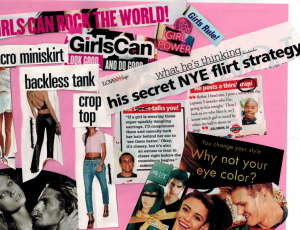When reading “Sultana’s Dream,” at first I was very aware of gender equality in Muslim societies and in Western societies, too. The story talks about a reverse situation where men are taking on the role of women in Muslim societies and I cannot help but think of a video where women’s roles in TV advertisements are replaced with men (https://www.youtube.com/watch?v=2SrpARP_M0o). The video was ridiculous and it is fascinating to think about women’s and men’s roles in society. Moreover, “Sultana’s Dream” to me was a commentary not only on how wrong sexism is but also how equally wrong reverse sexism would be. In other words, female empowerment should not be equated to male denigration (this was also something that I watched Kelly Cutrone comment on recently on television on America’s Next Top Model over Thanksgiving break–not the best show but great for rare moments of wisdom like this).
I believe Sultana’s Dream makes an excellent commentary on feminism (or rather women’s rights if people are adverse to the western connotations sometimes associated with the word “feminism”) and women in Muslim societies and the world in general! I wanted to do a similar piece through my collage of words and pictures taken from “Seventeen Magazine.” Interestingly enough, I think when I was gathering data from “Seventeen Magazine,” in other words reading “Seventeen Magazine,” I noticed that today (in comparison to perhaps a decade ago) there are more direct statements calling for “girl power” and empowering girls to “rock the world.” However, I find that ironic with a lot of the material generated in the magazine–for example, one statement comments on how “girls can look good AND do good.” Well, I guess my response would be girls can do good and look good (yes in that order of importance) if they want to and if they don’t then that’s their choice and their decision. It is in THEIR power to decide what looking and doing good means to them. Additionally, despite the recent addition of messages of female empowerment, I found it ironic that the magazine still encourages women and young girls to show as much skin as possible–hence the “micro miniskirt,” “the backless tank,” and “the crop top” which all manage to somehow expose some part of a girl’s epidermis to the air outside–what happens when winter comes? Anyhow, I purposefully used the words and headers to replace the female model’s heads because I felt that for the majority of the magazine anyhow the focus wasn’t on the female model but on the clothes and on her body anyways. I wanted to make this point especially clear. Moreover, I found interesting statements that encouraged women to change their looks, saying “you change your style. Why not your eye color?” and other advertisements for changing hair color. Although I am a strong proponent of “you’re perfect the way you are and don’t need to change a single thing,” I guess if a girl WANTS to change the way she looks it is entirely in her decision. I do however think that these advertisements do add some sort of additional pressure and influence that may suggest changing one’s appearance is necessary or conducive to one’s life when it is simply just a matter of personal choice. Moreover, I wanted to talk about the way men are brought up in this magazine–first of all, there was one section where a bunch of men were just talking about how they are able to “flirt” with girls and lure girls into their “trap,” which to me sounds absolutely horrifying and scary. The men spoke about women nonspecifically, not caring about the girl or the woman herself but rather de-individualizing the woman and stating their strategies for getting women as if this were some sort of game or some sort of hunting expedition. This was a problem for me. Lastly, interestingly enough in the article all of the advertisements with male models and female models happened to have the female model looking directly at the camera and the male model looking at the female which may or may not have connotations about a weird female-male girl/boy power balance. Either way, I found this magazine to be incredibly enlightening about what seventeen year old teenage girls are reading and almost a little disappointing and disheartening. Just as “Sultana’s Dream” made me more aware of the gender inequality in Islamic societies and the world in general and of the dangers of having reverse sexism, I found “Seventeen Magazine” to have the same effect on me and I hoped to capture such messages in my collage.


Recent Comments